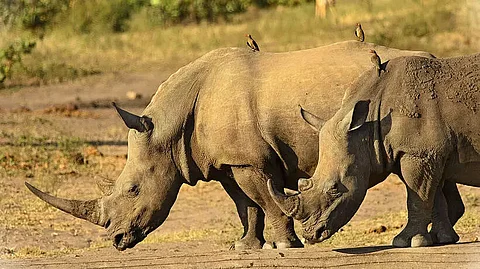
- Home
- Live Blog
- Breaking News
- Top Headlines
- Cities
- NE News
- Sentinel Media
- Sports
- Education
- Jobs

The Assam government has sent out a strong message against the poaching of rhinos for illegal trade of its horn by deciding to burn about 2479 rhino horns stockpiled in treasuries on World Rhino Day today. Wildlife parts contain no medicinal value and public destruction of such a huge stockpile of confiscated or recovered horns will help bust the myth about rhino horn being a high-value product having medicinal value. While poaching is one of the existential threats for one-horned rhinos of Kaziranga and other habitats, addressing several other conservation threats such as habitat degradation, flood and erosion, fodder shortage are also critical for its survival. Stockpiling of confiscated rhino horns only helped international traffickers to spread the myth of being a high-value product to inflate its prices in the illicit market. Besides, the stockpiles also remain vulnerable to theft and smuggling by traders of horns and thereby continuing the supplies even after poaching is effectively prevented by park authorities. It also helps the international gangs to convince local poachers, the majority of the unemployed youth, in the trafficking chain to get involved in the network to make money. Public destruction is expected to send across the message among local recruits in the poaching network that there is no future in the rhino horn market, and this will make it difficult for international gangs to find local collaborators. The myth of rhino horn having aphrodisiac and other medicinal value in countries like China, Vietnam spurred the flourishing illicit trade and one-horned rhinos of Assam became the targets of poachers to mint money from the flourishing transborder illicit trade. Rhino horn is a mass of compacted hair made of keratin-a protein that is also a basic component of human hair, skin and nails, and grows during the lifetime of the vulnerable species. Around five per cent of the stockpile of rhino horns will be kept preserved for scientific studies and as evidence for pending court cases and ensuring the protection of these horns will remain a priority for the Assam Environment and Forest department. Besides, preservation of any new horns to be confiscated from poachers in future will be required for evidence till the disposal of court cases. However, horns recovered from rhinos dying natural death or in floods must be destroyed immediately to prevent the stockpile from growing. Publicising every single destruction of rhino horn in future will reinforce the message sought to be sent across about the myth around rhino horn. While poaching of rhinos in Kaziranga has declined with the state government intensifying anti-poaching measures and strengthening park security, improved management of the World Heritage Site is crucial to sustaining the rhino conservation success story. Long-term park management requires expediting the construction of the proposed elevated corridor through Kaziranga National Park to facilitate safe migration of rhino and other park animals to safer places across the existing National Highway cutting through its landscape for taking shelter in high lands of Kaziranga-Karbi Anglong landscape. A rhino hit by a speeding vehicle while crossing the national highway and other park animals hit and killed in incidents of the vehicle hit during recent floods in the national park bore testimony to long-term implications of the delay in ensuring safe migration of rhino and other park animals in the entire habitat. Wild-to-wild translocation of rhinos to other protected areas planned under India Rhino Vision 2020 was an important conservation strategy with the objective of the increasing rhino population in the state to 3000, which ended in April this year. The success of the IRV 2020 also helped Manas National Park regain its World Heritage Site status when poaching led to wiping out its entire rhino population once leading to downgrading its status as World Heritage Site in danger. Birth of new rhino offspring to translocated rhinos in Manas scripted a new conservation success story and lessons learnt will be useful in deciding the new strategy and programme under India Rhino Vision. Addressing the problem of loss of land in rhino habitat due to unabated erosion in Kaziranga by the river Brahmaputra is critical to prevent straying of rhinos into nearby human habitations and turn easy prey for poachers. Siltation in the grassland in Kaziranga has also added to the degradation of rhino habitat and added to fodder shortage that needs formulation of an effective strategy to deal with such conservation challenges. Along with public destruction of horns to build awareness of the myth on rhino horns, addressing the new conservation challenges needs to be prioritised as a long-term conservation strategy. The application of DNA technology has opened new research areas and contributing to conservation programmes. The larger message of World Rhino Day is to ensure that Assam is not just the home for the largest population of one-horned rhinoceros, but also the safest and secure place for rhinos in the world.